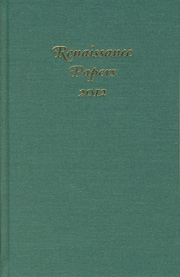Book contents
- Frontmatter
- Contents
- Dedication
- Reconstructing the Bower of Bliss: Homoerotic Myth-Making in The Faerie Queene
- Ovid, Lucretius, and the Grounded Goddess in Shakespeare's Venus and Adonis
- The Soul as Commodity: Materialism in Doctor Faustus
- Antipholus and the Exorcists: The Acts of the Apostles in Shakespeare's The Comedy of Errors
- Paul's Cross Churchyard and Shakespeare's Verona Youth
- The Summoning of Hamlet and Lear
- “Bred Now of Your Mud”: Land, Generation, and Maternity in Antony and Cleopatra
- Cosmetic Blackness: East Indies Trade, Gender, and The Devil's Law-Case
- From One Marvell to Another: Puritan Logic in “To His Coy Mistress”
- “An Heap Is Form'd into an Alphabet”: Thomas Blount's Sociable Lexicography
- Getting Past the Ellipsis: The Spirit and Urania in Paradise Lost
Paul's Cross Churchyard and Shakespeare's Verona Youth
Published online by Cambridge University Press: 05 December 2013
- Frontmatter
- Contents
- Dedication
- Reconstructing the Bower of Bliss: Homoerotic Myth-Making in The Faerie Queene
- Ovid, Lucretius, and the Grounded Goddess in Shakespeare's Venus and Adonis
- The Soul as Commodity: Materialism in Doctor Faustus
- Antipholus and the Exorcists: The Acts of the Apostles in Shakespeare's The Comedy of Errors
- Paul's Cross Churchyard and Shakespeare's Verona Youth
- The Summoning of Hamlet and Lear
- “Bred Now of Your Mud”: Land, Generation, and Maternity in Antony and Cleopatra
- Cosmetic Blackness: East Indies Trade, Gender, and The Devil's Law-Case
- From One Marvell to Another: Puritan Logic in “To His Coy Mistress”
- “An Heap Is Form'd into an Alphabet”: Thomas Blount's Sociable Lexicography
- Getting Past the Ellipsis: The Spirit and Urania in Paradise Lost
Summary
The more we learn about the physical environments and associated print culture of Paul's Cross Churchyard and the St. Paul's precinct of the City of London, the more we can understand how Shakespeare's plays were popularly received. It may seem that Shakespeare avoids direct reference to contemporary London—at least in comparison to Jonson, Middleton, and Marston, who satirize actual persons in their city comedies—but his references are more stealthy and intricate than theirs, and they are quite important in what they can tell us about the connections between drama and urban contexts during the Elizabethan period. Here I will focus on some colloquial banter between Romeo and Mercutio in Romeo and Juliet. Of course this banter, which first saw print in quarto versions of the plays in 1597 and 1599, belongs to the streets of London, not distant to Verona. More specifically, it points to the attitudes of the young gallants who contemporary records tell us were common in the St. Paul's precinct during the 1590s.
Two competing but also mutually beneficial cultural forces met within Paul's Cross Churchyard. The first involved dramatic preaching events and public proclamations, which promoted and were promoted by religious print sold by the booksellers. In many cases these booksellers surrounded the pulpit, and the fronts of their shops physically echoed the sounds of sermons coming from the pulpit. The second force was the new market for pleasure reading that flourished in surprisingly close proximity to religious expression.
- Type
- Chapter
- Information
- Renaissance Papers 2012 , pp. 41 - 52Publisher: Boydell & BrewerPrint publication year: 2013



